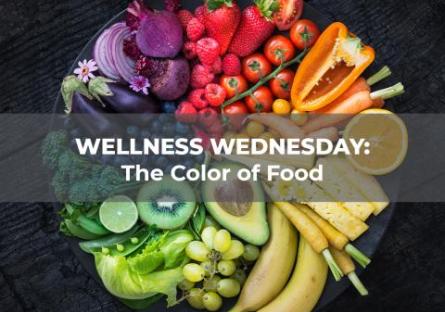This article appears for archival purposes. Any events, programs and/or initiatives mentioned may no longer be applicable.

Wellness Wednesday: The Color of Food
When it comes to fruits and veggies, you can judge a “book” by its cover! The bright colors that fruits and vegetables have are not just aesthetically pleasing — they convey crucial information about what’s behind that colorful skin. The pigments that give fruits and veggies their eye-popping hues represent a wide variety of nutrients and protective compounds. According to the Mayo Clinic, the different colors of vegetables and fruits “provide you with powerful antioxidants that can boost your immune system and provide protection.” This “nutrient rainbow” plays an important role in any balanced and healthy diet.
The Nutrient Rainbow:
- Red: red fruits and vegetables tend to be loaded with Lycopene, which has been linked with reducing breast and prostate cancer risk and may help boost heart, brain, bone, and eye health.
- Orange: contains Beta-Carotene, which can reduce inflammation, may help fight cancer, and supports immune system & vision health.
- Yellow: a healthy source of both Vitamin C and flavonoids, which may have cancer fighting inhibiting properties, detoxify harmful substances, boost the immune system, reduce inflammation, and support heart health.
- Dark Green: fruits and veggies with a darker shade of green tend to be high on Folate (which builds healthy cells and boosts heart health) and Calcium (which strengthens bones, muscles, and heart health).
- Light Green: a lighter shade of green indicates the presence of Allyl Sulfides (which destroy cancer cells and reduce cell division) and Indoles and lutein (which eliminate excess estrogen and carcinogens).
- Blue: blue fruits and veggies contain large doses of Anthocyanins, which destroy free radicals, reduce inflammation, and boost brain health.
- Pink/Purple: fruits like raspberries contain Resveratrol, which can decrease estrogen production and boost heart & brain health.
- Brown: brown nuts, grains, and fruits contain Fiber. Fiber can boost digestion and weight loss while also removing carcinogens.
*For more information, see this article on Heathline.com.
Curious where your favorite grocery store staples fall in the rainbow? Check out this handy chart and use it as a reference the next time you go shopping. And if you’re looking on tips for how to make veggies more flavorful, this article offers an excellent introduction to the joys of roasting, caramelizing, and pickling vegetables.
Want more wellness tips? Check out these stories: